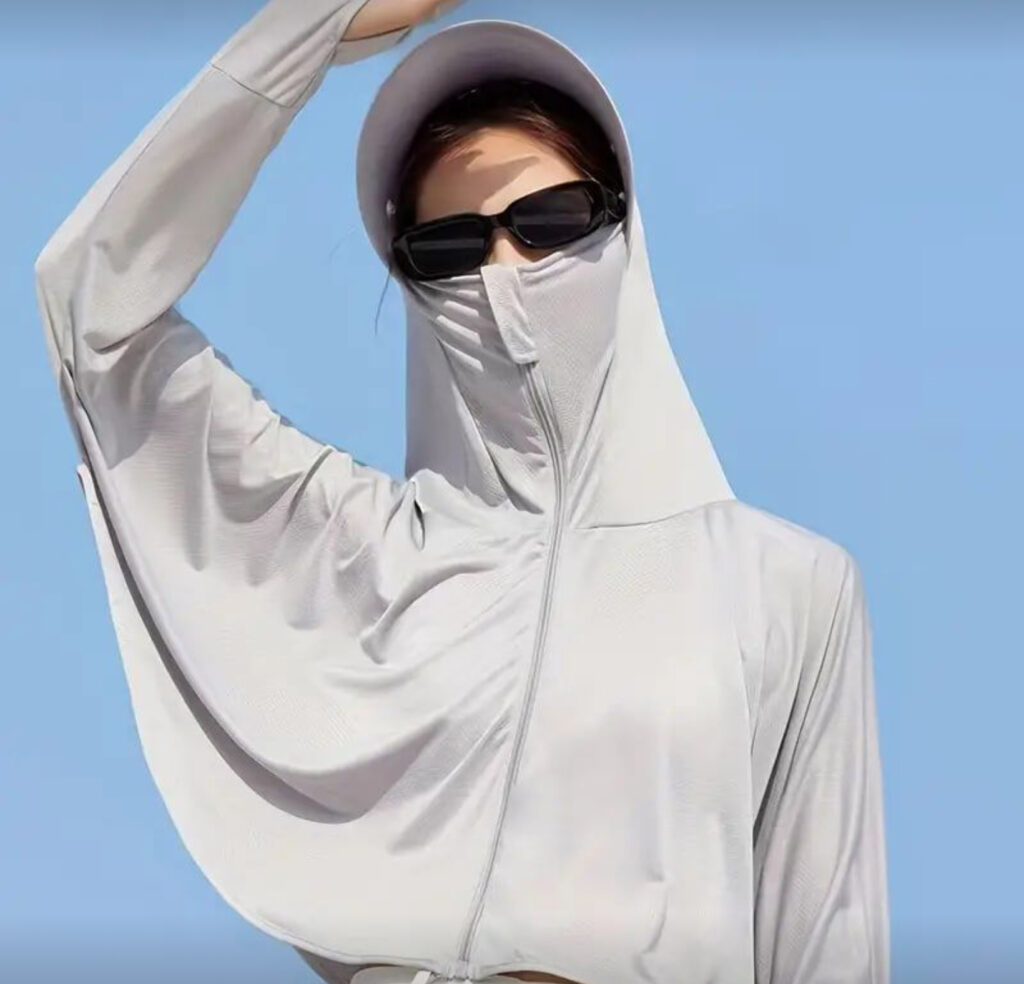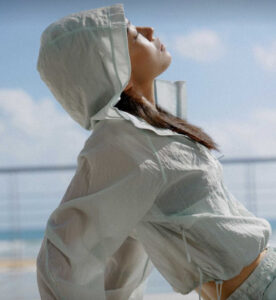In the realm of fashion, beauty has long been a pursuit of surface aesthetics — silhouettes, colors, trends, and forms that seduce the eye. Yet, as the climate crisis becomes more tangible, as temperatures rise and the sun no longer feels like a passive backdrop but a harsh adversary, beauty is transforming. It is no longer only about how you look, but how you live — and survive. Enter UV-protective clothing, an underrecognized but rapidly accelerating fusion of fashion, function, and skincare. The concept is no longer niche. It is revolutionizing wardrobes, particularly in Asia, where the category is now an estimated $10 billion market. What began as a solution for sensitive skin and sun-exposed lifestyles is now morphing into a cultural and aesthetic shift, one where clothing becomes both a cosmetic shield and a fashion statement.
CLOTHING AS SKINCARE
When the idea of “wearable skincare” first emerged, it was met with understandable skepticism. Leggings infused with hyaluronic acid? T-shirts with vitamin C linings? It sounded more like marketing folklore than functional design. But textile innovation has quietly advanced behind the scenes. Using microencapsulation, cooling fabrics, mineral-based weaves, and even graphene-infused fibers, manufacturers have been able to turn clothing into active defense mechanisms — not just passive covers.
UV-protective clothing sits at the intersection of this movement. Unlike sunscreen, which must be reapplied, these garments provide consistent UPF (Ultraviolet Protection Factor) ratings — similar to SPF in skincare. A UPF 50+ shirt can block over 98% of UVA and UVB rays. While in the West, this has mostly been limited to swimwear and hiking attire, in Asia — particularly in China, South Korea, and Japan — UV-protective gear is a thriving segment of everyday wear.
In countries where beauty standards often favor fair skin, and where aging prevention is deeply rooted in cultural beauty narratives, UV protection is not simply functional — it is aspirational. There’s a reason skincare aisles across Tokyo and Seoul feature SPF 50+++ in near every format, from sticks to gels to powders. UV-blocking fashion has now become a seamless extension of this philosophy.
THE BEAUTY ARMOR OF THE FUTURE
The products are unlike anything seen in most Western markets. There are sun hoodies with elongated necks that zip up to cover the mouth and nose — ideal for cyclists or commuters. Some brands have introduced detachable face shields woven into hoods, reflective and anti-microbial, shielding the face from both UV rays and pollution. Arm sleeves, cooling gloves, and long socks dominate department store racks during spring and summer, not just for athletes, but everyday wearers.
Perhaps the most surreal innovation lies in beauty-tech hybrids — leggings and tops infused with ceramides or hyaluronic acid, designed to slowly release moisturizing agents over time. As the fabric rubs against the skin, it mimics the benefits of a sheet mask or serum, creating a mobile skincare routine. The garments are washable, of course, and infused treatments are often said to last between 20 and 40 washes.
Luxury brands have yet to truly embrace the category, but domestic Asian brands are moving fast. SHEIN, though criticized for quality and environmental issues, has released UV-protective items targeting Gen Z. Meanwhile, more specialized brands like Bananaunder (China), Munsingwear (Japan), and Coolibar (U.S., with stronger presence in dermatology circles) have established reputations for combining sun-shielding function with elegant silhouettes.
BEYOND THE FEMALE GAZE — THE GROWING MALE AND CHILD MARKETS
While the UV-clothing boom has been historically marketed toward women — often under the guise of anti-aging or skincare — the category is quickly expanding into menswear and children’s wear. This is significant not only because it signals mass adoption, but also because it broadens the definition of beauty to include wellness, family, and care.
In China, brands have released adorable children’s ponchos with UV-reflective coatings and hats with full-coverage veils. Parents who are hyper-aware of environmental stressors are buying into the aesthetic of prevention. In Japan, where cultural norms around sun safety are more deeply ingrained, UV parasols and gloves are standard items in children’s school kits.
For men, the conversation is shifting too. As discussions around male skincare become less stigmatized and sun exposure is linked to premature aging and skin cancer, there is increased demand for stylish yet subtle sun protection. The aesthetic here leans toward minimal, utilitarian design — think slim-fit zip-ups, cargo pants in cooling fabrics, and matte-finish face masks. The language pivots from “beauty” to “performance,” but the underlying idea is the same: beauty as function.
FROM OUTDOOR UTILITY TO URBAN STYLE
If UV-protective fashion is the next iteration of wearable skincare, it is also a natural successor to the outdoorwear boom. Over the past decade, brands like Arc’teryx, Patagonia, and The North Face have rebranded utilitarian gear into aspirational lifestyle products. Gorpcore — the blending of outdoor silhouettes with urban fashion — helped transform bulky jackets, cargo pants, and hiking boots into cool-weather essentials for hipsters, influencers, and CEOs alike.
A similar transformation is underway in UV fashion. Originally designed for function (beach, bike rides, sports), these garments are now finding their way into everyday street style. In China, oversized UV ponchos are paired with mini bags and platform sneakers. In Japan, layered monochromatic looks incorporate gauzy UV-filtering wraps. On Korean streets, sunproof boleros and arm sleeves are styled with oversized button-downs or crop tops, transforming coverage into couture.
Design is catching up with demand. Brands are rethinking silhouettes, color palettes, and fabric feel — removing the clinical look in favor of fashion-forward cuts and textures. Soft neutrals, sheer overlays, and high-neck drapes evoke elegance rather than utility. These aren’t garments hiding the body — they are protecting it with intent.
THE CULTURAL GAP — WHY THE WEST IS BEHIND
Despite the growing scientific consensus about the dangers of UV exposure, UV-protective clothing has not taken hold in Western fashion markets the same way it has in Asia. Part of this comes from differing beauty ideals. In many Western cultures, tanned skin is associated with health, athleticism, and vacation — a luxury. The look of a golden glow has been mythologized for decades, from surf culture to supermodels.
But this ideal is slowly eroding. Rising rates of skin cancer, increased awareness of premature photoaging, and global warming are reshaping conversations around the sun. Dermatologists and beauty experts are leading the charge in promoting daily sun protection, including clothing. Brands like Uniqlo, which already offers the “UV Cut” line, have not widely marketed its protective function in Europe or North America — a massive missed opportunity given current trends.
What is needed is a reframing — UV protection not as a restriction, but as luxury. Just as clean skincare evolved from niche to norm, sun-safe fashion can follow the same arc.
THE FUTURE — TOWARD A BEAUTY-INFUSED WARDROBE
Looking ahead, the lines between beauty, tech, and fashion will only continue to blur. We already see hints of this: infrared-reflective fabrics for cooling, scent-infused garments, probiotic loungewear. The post-pandemic world has emphasized health as a lifestyle — and fashion is responding accordingly.
For UV-protective clothing to fully transition into mainstream beauty culture, it will need to shed its stigma of severity and embrace style. That’s already happening in Asia, where sunproofing is as much about grace as it is about shielding. Designers are now approaching UV garments with the same care and complexity they apply to ready-to-wear — thinking about drape, layering, skin sensitivity, and even psychological comfort.
Ultimately, the success of UV fashion lies in its ability to normalize protection without diminishing expression. Whether through a translucent hooded dress, cooling sleeves paired with a halter top, or a chic high-collared blouse, the idea is not to hide from the sun, but to meet it prepared — beautifully.
Flow
There’s something quietly radical about the rise of UV-protective fashion. In a world obsessed with fast trends and faster turnover, this category offers something more enduring: garments that care. Not just about style, but about skin. Not just about looks, but longevity. This is beauty reframed — not in cosmetics or contour, but in conscious design.
The real revolution lies not in the fabric itself, but in the philosophy it carries: that beauty doesn’t have to come at the expense of health. That fashion can be gentle. And that sometimes, the most beautiful thing we can wear is care itself.
No comments yet.








